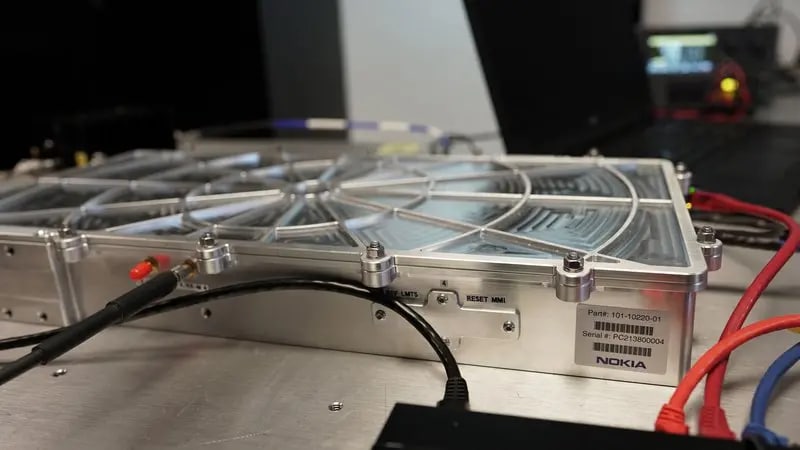Blast off! How Nokia is engineering an LTE network to survive a journey to the Moon

Recently my colleague Luis Maestro detailed the challenges we must overcome to deploy and operate an LTE/4G network at the lunar south pole as part of our work with NASA to prove the viability of cellular communications for future space exploration. But first things first: Before we can operate a network on the Moon, we need to get it there.
Transporting a network to the Moon is a bit more difficult than shipping a network to Boston. We are re-engineering components to survive the stresses of a 239,000-mile voyage through space. Without these measures, not even the most environmentally hardened terrestrial network would survive the mission.
We have lift off
Our LTE space-hardened equipment will be integrated into an Intuitive Machines Nova-C lander and a Lunar Outpost MAPP rover, which will, in turn, travel aboard a SpaceX Falcon 9 rocket to space. A rocket launch is essentially a controlled, sustained explosion that accelerates the rocket at enormous speeds, and it generates two big threats to the integrity of any equipment: shock and vibration.
Let’s start with vibration, which is caused by the rocket’s engines and the enormous friction created when punching through the Earth’s atmosphere. Vibration is interesting because it doesn’t necessarily dissipate as it gets further away from its source. A vibration at launch, for instance, could amplify as it travels through joints and structural components away from the engine. Therefore, small levels of vibration at the bottom of the rocket could lead to amplified vibrational loads on the payload at the top of the rocket. That makes an unanticipated vibration potentially catastrophic, causing the network equipment to literally shake itself apart.
We must also deal with shock. Our system needs to survive the shock of the initial launch, but that’s a relatively minor consideration compared to the shock generated by the separation of the rocket’s stages. Unlike vibration, shock forces weaken with distance. At liftoff, the rocket’s main engines generate tremendous forces, but the payload is at the top of the rocket where it is partially insulated from them. However, the rockets remaining stages are much closer to the payload. So when those stages separate, generating large shock events, our network equipment will definitely feel the effects. Finally, when the nose cone that protects the payload during liftoff is ejected, the equipment will experience another big jolt.

All these forces put large stresses on our equipment. Soldered joints could fail. The more delicate internal parts of components could break. Components could come loose. For instance, we use oscillators to provide key timing functions for all the network’s circuitry. Those oscillators are basically quartz crystals. Even if they didn’t break, vibration or shock could induce a frequency shift that could significantly impact the network or cause it to cease working entirely.
So how do we overcome these challenges? Testing, lots of testing. Working with NASA and our partners Intuitive Machines and Lunar Outpost, we have subjected our equipment to every conceivable stress we expect to encounter during that critical launch phase.
We’ve essentially performed three types of tests: acceleration, shock and vibration. While all hardware elements underwent multiple testing rounds, our base station has definitely seen the most. For instance, we have shaken the base station on vibration tables. We’ve jacked the base station up into the air and then dropped it to ensure nothing breaks. We even placed the base station in giant centrifuges that simulate the intense acceleration forces experienced during launch.
In the process we have broken some things, which has sent us to the drawing board to engineer more hardened alternatives. That’s one of the main reasons our base station has undergone so many testing cycles. Using the data gathered from each test, we have evolved aspects of its mechanical design. This process simulates as closely as possible the conditions our equipment will face during an actual launch, but just to be certain we’ve built in margins and have tested our equipment under conditions that exceed the mission’s parameters.
The voyage to the Moon
Once the final rocket stage separates and we escape the Earth’s atmosphere, the “hard” part is over. In no other leg of the journey will we encounter the severe stresses experienced during the first ten minutes of flight. While touching down on the lunar surface near the Shackleton Connecting Ridge will produce some shock and vibration, they will be nothing like the forces generated at launch.

That said, we did need to make adjustments for the transport and operation of the network post-launch. When we move network equipment on Earth, we typically don’t transport it through vacuum, which can have some unusual effects on our network components. For instance, common components used in any LTE network contain unsealed liquids, which would boil off into the void once exposed to the vacuum of space. Those liquids needed to be replaced with solid components. We also needed to identify and avoid materials that release gases when exposed to vacuum conditions. Those gases could deposit on our equipment or our partners’ equipment causing them to malfunction. Dealing with vacuum, however, will be most critical in the operational phase of the mission, which we will cover in a future blog post.
Planned for 2024, the mission’s launch is fast approaching, but there is still much work to do before the countdown starts. While we’ve done multiple barrages of testing already, we’ll do many more.
It’s critical we get it right. A single malfunctioning component could mean the difference between mission success and failure. A small piece of equipment breaking loose during launch could not only damage our network but Intuitive Machines’ lander or Lunar Outpost’s rover, jeopardizing their mission success, not just ours. We’re all in this together, so we’re consequently working closely to ensure everything is working right.
This is an uncrewed mission after all. There are no repair crews on the Moon.
Images from top to bottom: 1) Space X Falcon 9 rocket, image credit: NASA/Joel Kowsky; 2) Nokia equipment in the testing lab, image credit Intuitive Machines; 3) Vacuum chamber at NTS Boxborough, Massachusetts
